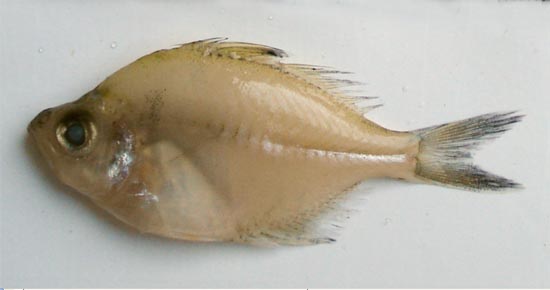
Synonyms:
Equula edentula: Day, 1878; Day, 1889.
Scomber equula Forskal, 1775.
Leiognathus equulus: Weber and de Beaufort, 1931; Munro, 1955.
Common name: Common pony fish (English).
Bangla name: Tak chanda, Tak mach, Taka chanda.
Taxonomic position:
Phylum: Chordara
Class: Osteichthyes
Order: Perciformes
Family: Leiognathidae
Genus: Leiognathus
Species: L. equulus
Morphological description:
Body is deeply compressed. Dorsal profile of the body is strongly arched, distinctly more convex then its ventral profile. Mouth is small with thick lip. Spines of dorsal fins are moderately strong. Pelvic is near the anal. Scales are very small and cycloid. Lateral line is complete. Caudal forked lobes and rounded. Colour bright silvery, grayish along the lateral line. In the living or fresh specimen the body shows dazzling white colour. Base of pectoral stained gray. The morphological description of this species is quite similar to Rahman (2005), Talwar and Jhingran (2001) and Bhuiyan (1964).
Fin formula:
D. VIII/14-16, P1. I/15-17, P2. I/5, A. III/13-15.
D. 8/15-16, P1. 20, P2. 1/5, A. 3/14 (Bhuiyan, 1964).
D. VIII/15-16, P1. 20, P2. I/15, A. III/14 (Shafi and Quddus, 1982).
D. VIII/15-16, P1. 2/18, P2. I/5, A. III/14 (Rahman, 2005).
D. VIII 16, P1. i 19, A. I 5, A. III 14 (Talwar and Jhingran, 2001).
Habit and habitat:
This species found in estuaries and rivers. It is available in plenty in the Meghna river (Bhuiyan, 1964). This fish is surface dwellers and omnivorous.
Breeding time:
Breeding time is July-November (Bhuiyan, 1964).
Economic importance:
This small delicious fish is in great demand for its high taste and good flavour (Bhuiyan, 1964). Drying chanda fish sells in local market as well foreign market.
Ecological role:
Surface dwellers and takes small insects, unicellular algae and in culture pond take wheat bran and fish meal (Talwar and Jhingran, 2001).
Marketing status:
The price of this species varied between 35-65 Tk/kg. Usually it is marketed in fresh or in dried form.
References:
Bhuiyan, A.L. 1964. Fishes of Dacca. Asiatic Soc. Pakistan, Publ. No. 13, Dacca. pp. 103-104.
Day, F. 1878. Fishes of India. William Dowson and sons., London. p. 238.
Day, F. 1889. Fishes. Fauna. Brit. India. William Dowson and sons., London. 1-2: p. 186.
Forskal, 1775. Descript. animal. p. 75.
Munro, I.S. 1955. Marine and Freshwater Fishes of Ceylon. Dept. External Affairs, Canbarra Publications. p. 146.
Rahman, A.K.A. 2005. Freshwater Fishes of Bangladesh. The Zoological Society of Bangladesh, Dhaka. pp. 335-336.
Talwar, P.K. and Jhingran, A.G. 2001. Inland Fishes of India and Adjacent countries. Oxford and IBH Publishing Co. Pvt. Ltd. New Delhi. 2: pp. 831-832.
Weber, M. and de Beaufort, L.F. 1931. Fishes of the Indo-Australian Archipelago. E.J. Brill. London. 6: p. 322.
Shafi, M. and Quddus, M.M.A. 1982. Bangladesher Matshya Sampad (in Bengali). Dhaka. pp. 270-271.
Visited 3,074 times, 1 visits today | Have any fisheries relevant question?
